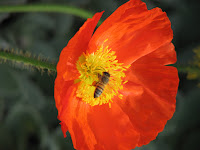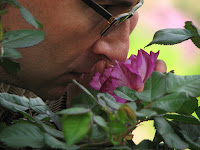 by Patricia Lamkin
by Patricia LamkinMusicians and poets have praised it, contemplating its mystique. Tongue-tied lovers let it speak for them, when words were not enough. Gardeners lavish it with affection, despite its forbidding thorns. It is the rose, and for centuries its undeniable charm has suggested romance, beauty and love.
In the world of rose breeding, scientific terms like 'pollen parent,' 'seed parent,' 'cultivar,' and 'hybrid,' might contradict our romantic notions, but the rosarians who use them are quite passionate about what they do.
David Austin loves roses. A farmer turned nurseryman, in his youth Austin loved the opulent and fragrant Old Garden Roses: Gallicas, Damasks, Albas, and Centifolias, and set out to create a new version of the Old Rose which would have the same old fashioned fragrance and grandeur as the original, but with the repeated blooms and color variations of Modern Roses. The result of this vision was the English Rose, a “new rose in the old tradition.” In 1983 two of these roses, ‘Graham Thomas’ and ‘Mary Rose’ were an international sensation when they were introduced at the Chelsea Flower Show. Since then over one hundred and fifty varieties of English Roses have been introduced by Austin, making his nurseries one of the world's preeminent breeders.
World-renowned rose authority Michael Marriott has been with the David Austin UK nursery for 22 years as a nursery manager, garden designer, lecturer, and writer. As Technical Manager, Marriott knows firsthand what makes David Austin roses so spectacular: “David Austin has a very firm idea about what he wants his roses to look like, which includes...a beautiful bloom in the style of the Old Roses, a wonderful fragrance, good health and attractive shrubby growth."
"But the most important character is that it should have an overall beauty and charm," he continues. Yet with all of his technical expertese, even Marriott can't quite put his finger on what this is. "These last two characters are very difficult to define but easy to recognize and very much appreciated by gardeners."
 |
| L to R: David Austin, David Austin Jr. and Michael Marriott. |
Even hybrid roses express a romantic mystique. But how are they made? “By transferring pollen from one variety to another,” Marriott explains. When the parent plants are just ready to bloom, the young petals are peeled away revealing the stamens which are carefully removed. "They are kept at 70F overnight by which time the pollen has been released and can be used on the stigma of a flower of another variety,” he says.
The Subject Was Roses
Wilhelm Kordes is a fourth generation German rosarian whose family have been respected rose breeders since 1887. At a recent lecture series called "Great Rosarians of the World" hosted by Huntington Botanical Gardens in San Marino, Kordes passionately descibed this seemingly unromantic reproductive process.
 |
| Pollination, the old fashioned way. |
This process begins with 1400 mother plants, uses 2,000 pollination-flower combinations, producing 100,000 pollinated flowers. But that’s just the beginning.
The fruit of these labors are plump, red rose hips. “If the hip sets, it can be harvested several weeks later when it has turned red or orange,” said Marriott. The hips are filled with rose seeds. Though the numbers vary between cultivators, about 60 to 80,000 hips are harvested, making about 800,000 seeds, which become about 400,000 seedlings one year later.
When these seedlings flower, the ones not up to par are destroyed. Clair Martin, Curator of The Huntington’s Rose Collection, elaborated on this process. “A hybridizer like Jackson Perkins or David Austin will grow ¼ million to ½ million seedlings per year. Many of these die, they don’t do well, they get diseases, or they aren’t pretty – so they get culled out. In the first year, they scale down to about 100 roses, and then finally down to just a few.” Qualities breeders look for include disease resistance, frost tolerance, heat resistance, color, shape and fragrance.
To achieve these select few roses, groups of plants are grown in trial fields over 8 or 9 years. Yes, years. When all is said and done, only 5 or 6 varieties remain, the crème de la crème of the original seedlings, and they are, of course, gorgeous.
 |
| As for the parentage of these prize winning roses, at David Austin nurseries, that is a closely guarded secret. |
The Name of the Rose
"What's in a name? That which we call a rose by any other name would smell as sweet."
So says Juliet in the balcony scene in Shakespeare’s famous romantic tragedy, Romeo and Juliet. But this romantic notion translates into something else for rose breeders, for “that which we call a rose” must bow to sales and marketing.
Each new variety of rose is patented and trademarked so that the hybridizer gets royalties, and then assigned official botanical family and species names. But it also gets a marketable common name. As an appropriate example:
Species: Rosa, 'William Shakespeare 2000', Family: Rosaceae, 'William Shakespeare 2000' being the common name.
“A rose’s name is essentially sales driven,” says Martin, “Hybridizers make the name decisions, and this is based on price.”
While price is definitely a factor, David Austin seems to enjoy christening roses. He names them after characters from Shakespeare and Chaucer, "Othello" and "Wife of Bath" for example; and famous landmarks in Britain, ‘Winchester Cathedral." Several of his cultivars have been named after members of his family ("Lillian Austin" and "Pat Austin"), this being one of the perks of the job.
One of his newest varieties is ‘The Huntington Rose,’ is a deep pink flower with a many-petalled center.
 |
"The Huntington Rose" Photo courtesy of David Austin Roses UK |
This comes as no surprise. Martin shares Austin’s passion for Old Roses, having written two books on the subject: 100 Old Roses for the American Garden and 100 English Roses for the American Garden. For the latter work, Austin wrote the introduction.
But even a rose as nobly named as the Huntington Rose might have a different name in another country. Martin himself compares it to the naming of cars: "When Chevy came out with the Nova, it didn’t sell in Mexico, because Nova means ‘won’t go’ in Spanish."
Case and point, in England, The Huntington Rose began as something else entirely. “We renamed it from 'Alan Titchmarsh,'” explained Marriott, “who is the best known gardening presenter in the UK. We thought that 'Alan Titchmarsh' as a name for a rose wouldn't go down too well in the US.”
Whatever their names may be, roses have been cross-bred through the ages, going back 5,000 years. Though the modern process is more technical and precise, the rose somehow belies this control, and maintains a romantic quality that even the greatest rosarians cannot put into words.
A Bonny Bunch of Roses
Like the creation of roses themselves, designing a rose garden is a rewarding labor that involves careful planning. Interior designer Alexandra Anderson of Alexandra Anderson Design Atelier in Beverly Hills explains that designing gardens and outdoor spaces involves creative cooperation.
 |
| Alexandra Anderson |
 |
| Rose garden in Holmby Hills, CA with David Austin roses. |
 |
| Anderson found this 20th century marble dog for a garden patio. |
Obediently welcoming outdoor dining guests, this pooch won’t beg for table scraps.
Anderson also helps clients choose the right fabric patterns for use on their terraces. “The fabulous weather in Southern California causes clients to want to take advantage of all aspects of their properties,” she says. “The innovations in outdoor furniture and fabrics have enabled the interior designers to create stylish, comfortable outdoor rooms that become as important as the rooms of the interior.”
I Never Promised You A Rose Garden
Our fabulous dry weather might be one of the biggest challenges for anyone wanting an English garden in Southern California. Because English gardens are seasonal, and use more annual plants, it is impractical to imitate them exactly. Trying to create a true English garden here would be “an irresponsible endeavor in our parched state,” Beall says.
“Here, English gardens tend to be more perennial than annual and we try very hard to make sure the gardens don't have a down time; we are so used to seeing things green year round. It is an enormously difficult task because everything has some form of downtime,” Beall says.
Luckily, English "New Wave" designs use CA natives such as Ceanothus, Fremontodendron, and Penstemon. Mediterranean plants like Lavender or Santolina, tropical plants like Cannas and Citrus, or exotics like Cordyline and Yuccas all work very well. “The English are mad about plants from all over the world,” says Beall.
 |
| Layers and color are used in garden design. |
Beall enjoys using roses in many types of gardens. “Mediterranean gardens especially,” he said. “Formal French Style gardens, modern gardens, Chinese gardens. I think just about anything could include roses but perhaps not used in the traditional sense.”
Stop and Smell the Roses
 |
| Tim Lindsey does exactly that. |
The Rose Garden sits by a small tennis court. Hybrid teas, known for their sweet frangraces and traditional shapes, are the preferred rose in formal designs like this one. “The colors of these roses range from light pink to red,” said Lindsey. Blush pink is echoed in the tennis court wall, being a favorite color of Virginia Robinson.
 |
| Classical statues are a common motif of formal rose gardens. |
 |
| Lantana interspersed with crocosmia. |
 |
| Repeating rose arbors create a sequential rhythm, and frames for viewing the far off landscape. |
 In Greek myth, Chloris, the goddess of flowers, is said to have created the rose from a lifeless nymph she found in the woods. Her creation was such a delight that the other gods were inspired to help. Aphrodite the goddess of love bestowed on it beauty, Dionysus the god of wine gave its lovely scent, and the West Wind Zephyr parted the clouds so that the sun god Apollo could shine on it.
In Greek myth, Chloris, the goddess of flowers, is said to have created the rose from a lifeless nymph she found in the woods. Her creation was such a delight that the other gods were inspired to help. Aphrodite the goddess of love bestowed on it beauty, Dionysus the god of wine gave its lovely scent, and the West Wind Zephyr parted the clouds so that the sun god Apollo could shine on it.
Whether one's passion is creating roses or rose gardens, like the myth, everyone wants in on the project. The rose is a designers flower, and has been for thousands of years. What can be more romantic than that?
No comments:
Post a Comment